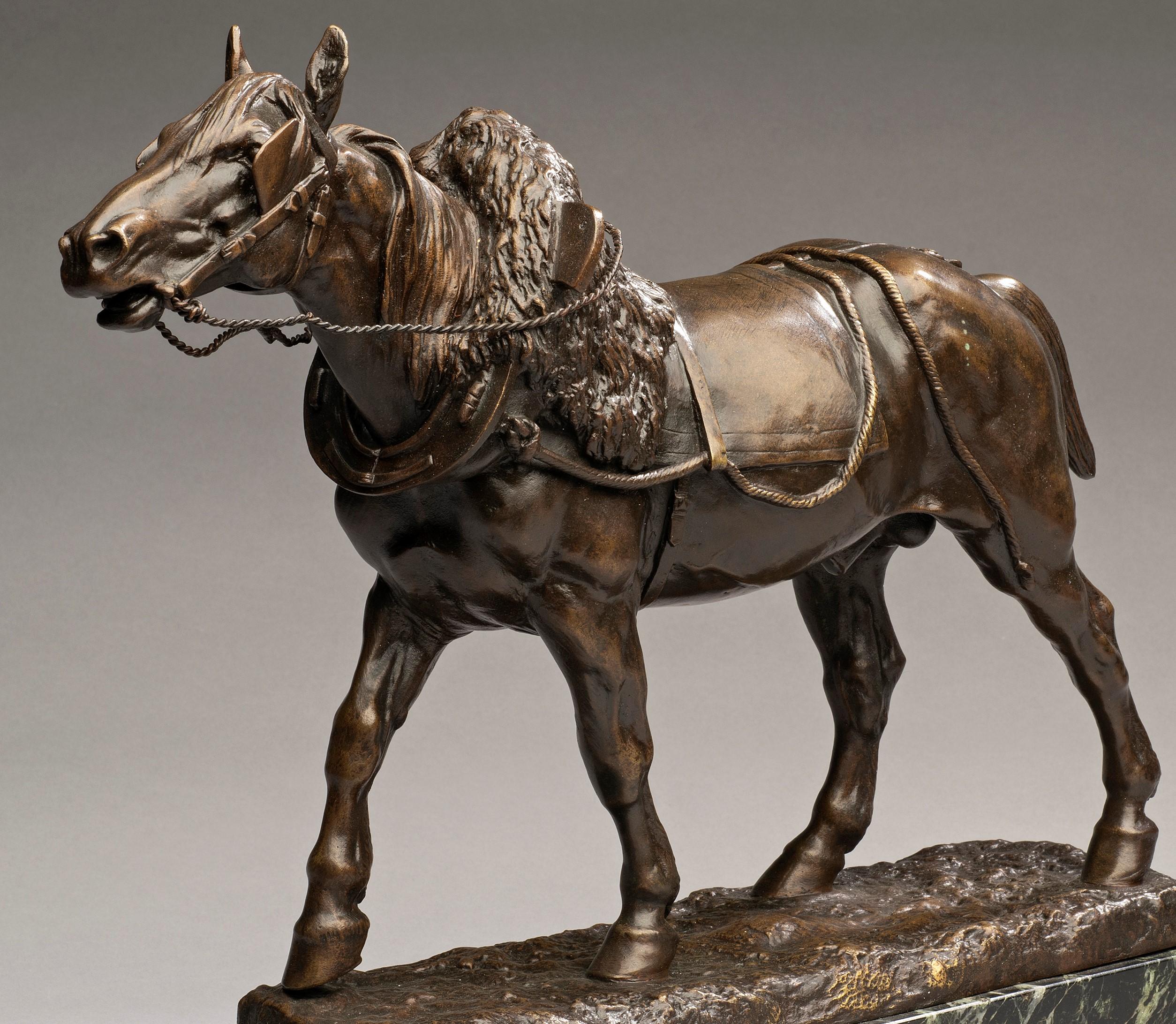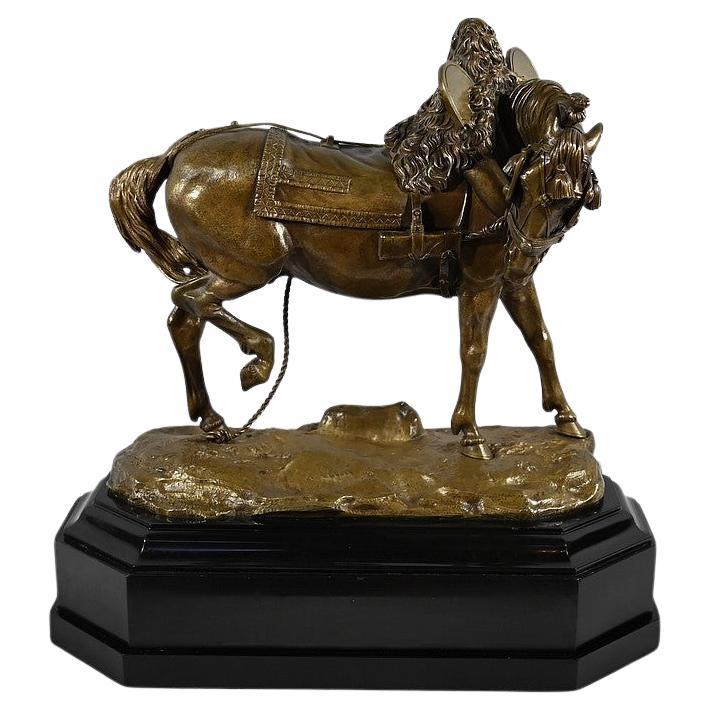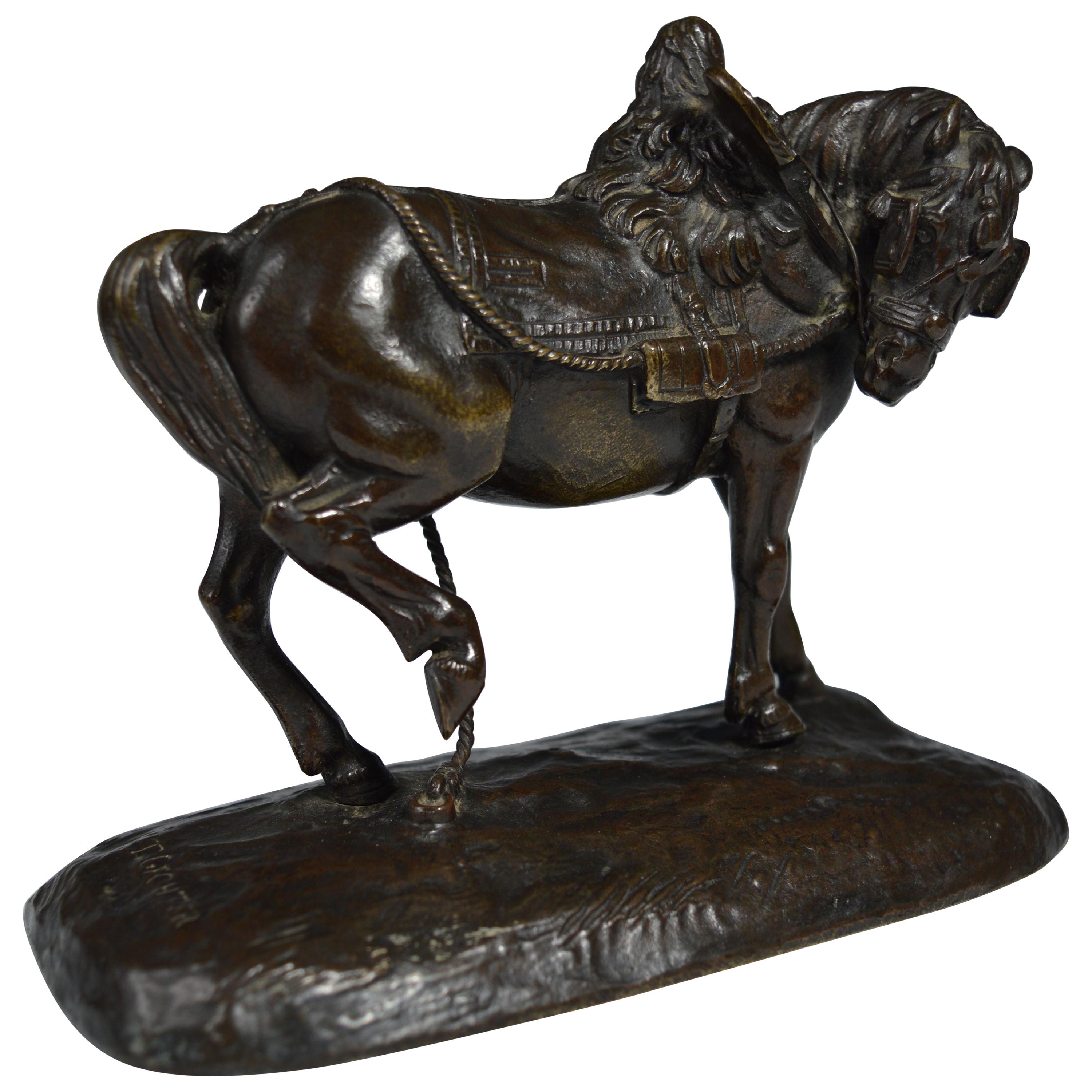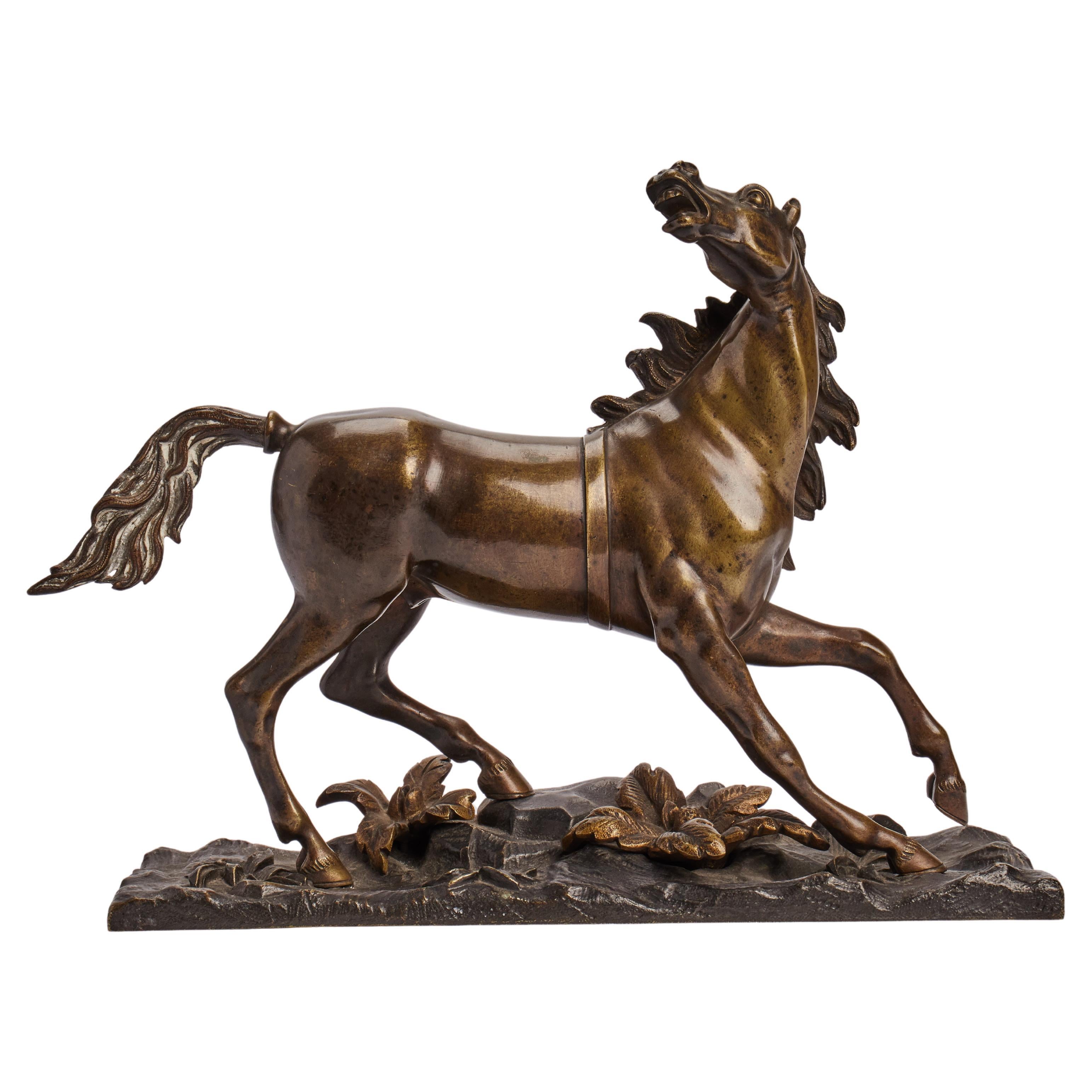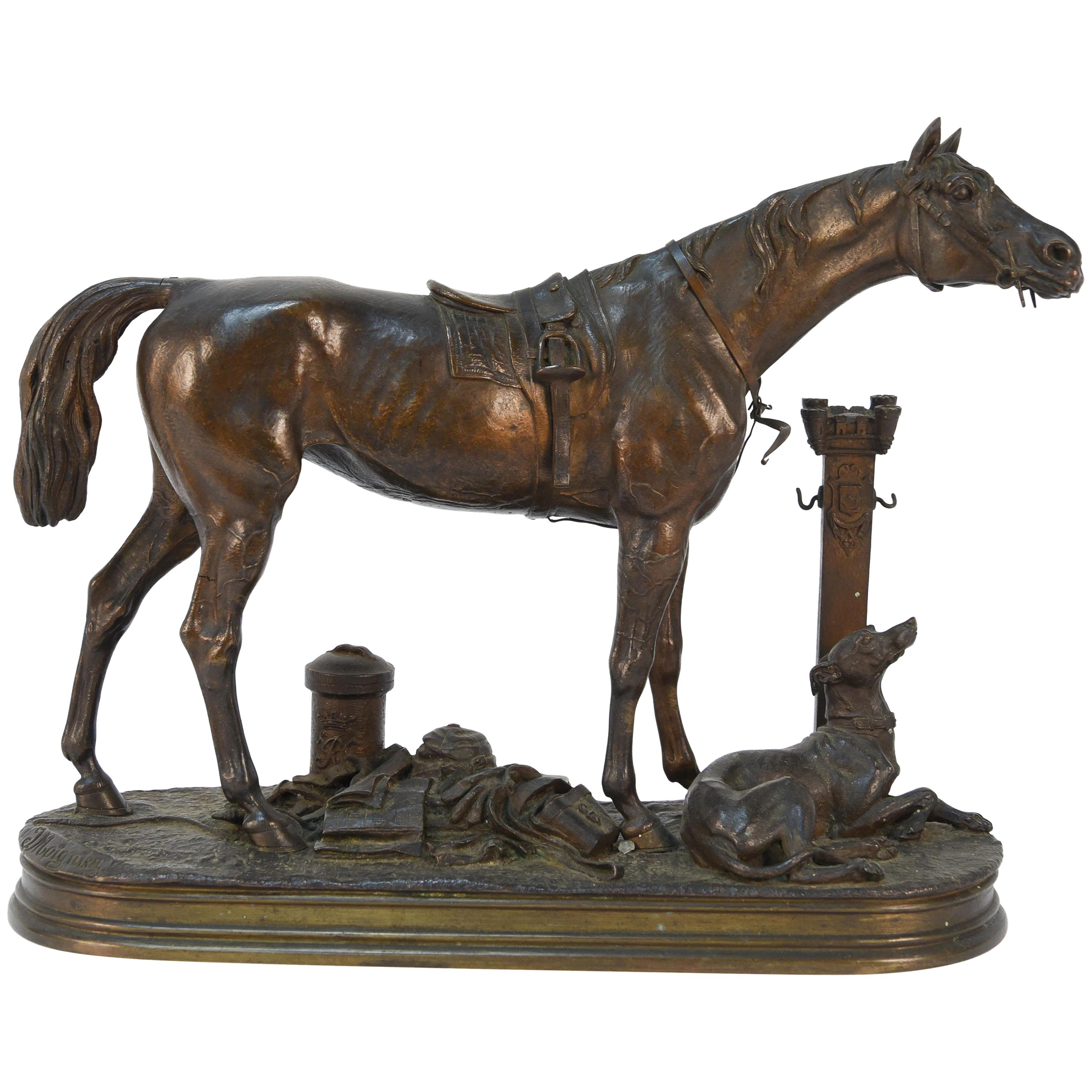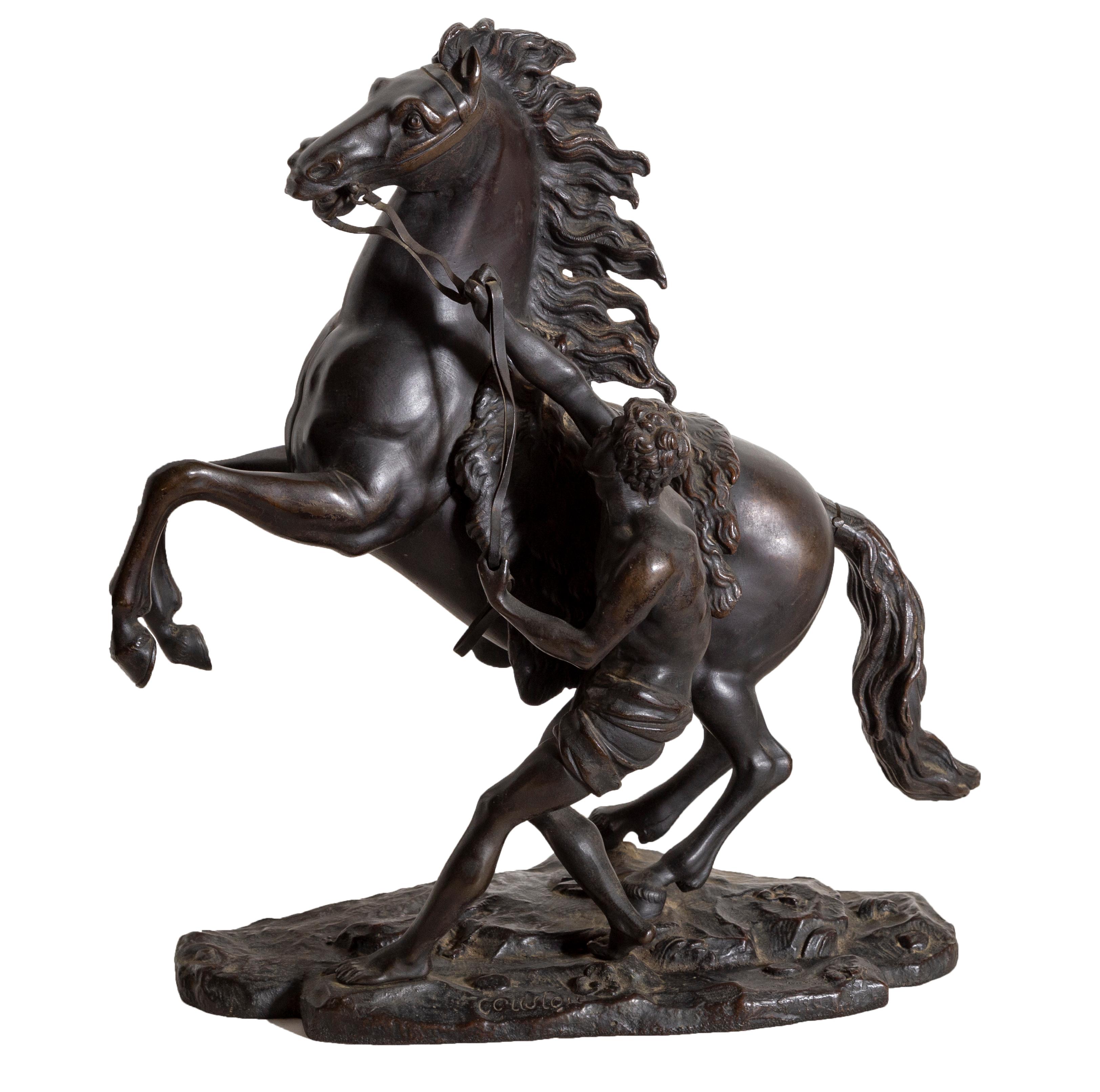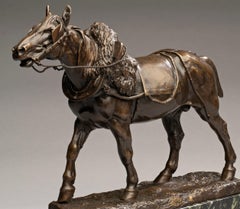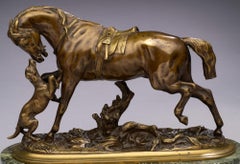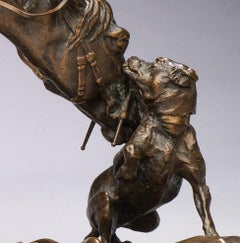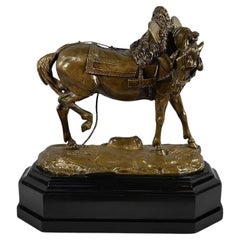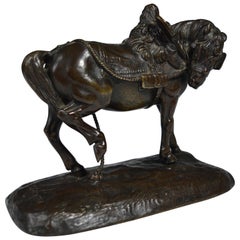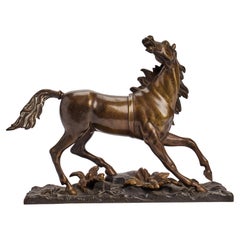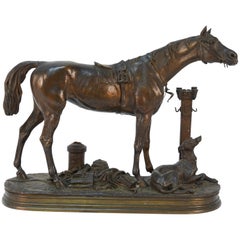Items Similar to Antique Exceptional Bronze Draft Horse by Pierre Jules Mêne (French, 1810-1879)
Want more images or videos?
Request additional images or videos from the seller
1 of 13
Pierre Jules Mêne Antique Exceptional Bronze Draft Horse by Pierre Jules Mêne (French, 1810-1879)Circa 1860s
Circa 1860s
$2,350
£1,775.82
€2,050.63
CA$3,283.77
A$3,643.62
CHF 1,908.61
MX$44,680.56
NOK 24,276.82
SEK 22,916.28
DKK 15,292.86
Shipping
Retrieving quote...The 1stDibs Promise:
Authenticity Guarantee,
Money-Back Guarantee,
24-Hour Cancellation
About the Item
Antique Horse Bronze
Exceptional Bronze of a Draft Horse
Pierre Jules Mêne (French, 1810-1879)
Circa 1860s
4 3/4 (W) x 3.25 (H)
As Mêne personally oversaw the fabrication of each one of his pieces and was obsessive about quality, this little bronze is truly superb. The casting is highly refined and clear with minute details with deep, warm patina. This is a ridiculously fine bronze in a small package.
Pierre Jules Mêne (1810-1879), aka P.J. Mêne, was the son of a metalsmith, and received his earliest teaching on sculpture and foundry work from his father. Although mostly self-taught, having never attended any of the prestigious art schools, Mêne was also influenced by the painters Edwin Landseer of England with his expressive sentimentality, as well as Carle Vernet of France, in capturing spirit, grace and compositional beauty in sculptural form. Mêne began his career and earned his living by doing small jobs with metals such as furniture adornments and clock decorations.
Ultimately, P. J. Mêne was one of its earliest pioneers and subsequently became one of the most prolific, and probably the best-known, animalier sculptors. Like so many animalier of the day, Mêne's early studies were made at the Jardin des Plantes in Paris, where he developed his great talent for animal sculpture. Mêne did not sculpt statues, but rather bronze statuettes most frequently of domestic and farm animals at rest, (horses, dogs, cows, bulls, sheep, and goats). His favorite subject was the horse, of which he is considered to be the master at portraying. Next to horses, Mêne modeled many sculptures of dogs, both at work and at play. He created bronze sculptures ranging from animal portraits, to combat groups, to domestic animals, and equestrian groups of both racing and hunting.
Mêne's earliest works reflected Antoine-Louis Barye's influence, but in contrast with the romantic style of Barye, Mêne excelled in realistic portrayals of animals, sculpting each in their natural habitat, capturing fleeting movements and delicate details.
Generally, his sculptures were portraits with a hint of human personality. Mêne was praised for his "perfection in modeling the figures of animals, and for the truth and beauty of his representations." He worked in the Juste Milieu, blending romantic and naturalist elements while retaining a degree of traditionalism.
Beginning in 1838 Mêne began work at his own foundry, casting his own works and later also those of his son-in-law Auguste Cain. He became absorbed in the meticulous work of casting and chiseling and ensured that they were always checked for quality, color, and finish before they were allowed to leave the foundry. Each cast was of the highest quality and finest patinas. The last cast of an addition was edited as sharply as the first, and he was meticulous in the after work of his bronze casts, chiseling the extremely fine details. His bronzes were signed in block letters "P. J. Mêne" with no foundry marks. Declining many offers to do monuments, Mêne instead concentrated on his successful business of producing and marketing his very popular bronze sculptures. His only sculpture acquired by the State of France during his lifetime was the bronze Mounted Huntsman and His Hounds.
Auguste Cain, who continued Mêne's foundries from 1879 to 1892. Subsequently, Mêne's models were sold to the Barbedienne and Susse Freres Foundries which cast well into the 20th century. Though of fine quality, these later casts by Barbedienne and Susse Frères do not have the vitality and attention to detail that Mêne achieved on the casts from his own foundry.
Charming and charismatic, Mêne was accepted socially within the various French artistic communities. He was just as comfortable entertaining the intellectuals of Paris as he was with his apron on among his foundry workers. Through his notable charm, he drew the finest craftsmen to work for him in his foundry and his home became a fashionable meeting place for the painters, sculptors, and musicians of Paris.
It was in 1838 when he first exhibited a bronze statuette at the Paris Salon. From that time on, Mêne exhibited regularly until his death, ultimately receiving four awards from the Salon. Many of Mêne’s subjects were shown to the general public in this popular showcase where acclaim and criticism could be judged before including the subject in his general Oeuvre. This also served to establish public awareness of his new works and provides a useful reference when dating the origin of a particular cast.
In 1861 Mêne was awarded the Cross of the Legion d'Honneur in recognition for his contributions to art. He exhibited in England at the Great Expositions of 1855, 1867 and 1878, where he was praised as the "Landseer" of sculpture.
Mêne died on 20 May 1879 in Paris, France. He is remembered as one of the finest, and certainly the most prolific, animalier sculptors of all time.
Today, his works are held in the collections of the Louvre Museum in Paris, the National Gallery of Art in Washington, D.C., and the Courtauld Institute of Art in London, among others.
- Creator:Pierre Jules Mêne (1810 - 1879, French)
- Creation Year:Circa 1860s
- Dimensions:Height: 3.25 in (8.26 cm)Width: 4.75 in (12.07 cm)Depth: 2.25 in (5.72 cm)
- Medium:
- Movement & Style:
- Period:
- Condition:This remarkably refined bronze is in excellent condition.
- Gallery Location:SANTA FE, NM
- Reference Number:1stDibs: LU1408211253172
About the Seller
5.0
Platinum Seller
Premium sellers with a 4.7+ rating and 24-hour response times
Established in 1995
1stDibs seller since 2020
117 sales on 1stDibs
Typical response time: <1 hour
- ShippingRetrieving quote...Shipping from: Santa Fe, NM
- Return Policy
Authenticity Guarantee
In the unlikely event there’s an issue with an item’s authenticity, contact us within 1 year for a full refund. DetailsMoney-Back Guarantee
If your item is not as described, is damaged in transit, or does not arrive, contact us within 7 days for a full refund. Details24-Hour Cancellation
You have a 24-hour grace period in which to reconsider your purchase, with no questions asked.Vetted Professional Sellers
Our world-class sellers must adhere to strict standards for service and quality, maintaining the integrity of our listings.Price-Match Guarantee
If you find that a seller listed the same item for a lower price elsewhere, we’ll match it.Trusted Global Delivery
Our best-in-class carrier network provides specialized shipping options worldwide, including custom delivery.More From This Seller
View AllAntique Bronze Portrait Draft Horse by Isidore Jules Bonheur (France, 1827-1901)
By Isidore Jules Bonheur
Located in SANTA FE, NM
Antique Bronze Portrait of a Draft Horse
Isidore Jules Bonheur (France, 1827-1901)
Circa 1840s
Cast bronze mounted on a rectangular plinth atop a marble s...
Category
1870s Realist Figurative Sculptures
Materials
Bronze
Antique Horse Bronze Trotting Stallion Isidore Jules Bonheur (France, 1827-1901)
By Isidore Jules Bonheur
Located in SANTA FE, NM
Antique Horse Bronze
Portrait of a Trotting Stallion
Isidore Jules Bonheur (France, 1827-1901)
Cast bronze mounted on a rectangular plinth with dark brown patina,
Signed: I. BONHEUR
17 x 11 3/4
A brilliant exploration of a stallion in full trot. The patina is a deep, warm walnut brown with honey-colored tones.
Isidore Bonheur was best known and the most distinguished of the 19th century French animalier sculptors. Isidore, the younger brother of Rosa Bonheur and older brother of Auguste, began his studies of painting initially with his father, who was friends with Francisco Goya. By 1848 he debuted at the Paris Salon having discontinued animal and landscape painting to concentrate on creating sculptures and in 1849, Bonheur enrolled at the Ecole des Beaux Arts. He won medals at the Paris Salon in 1859 and did so again in 1865 and in 1869. After entering the Exposition Universelle 1855, he won the Gold Medal in 1889. In the 1870s exhibited in the London at the Royal Academy of Arts where he earned great prestige and won the coveted Medaille d’Or. After winning numerous other medals and prizes, Bonheur was awarded the Legion d' Honneur in 1895 and he was Knighted in Portugal, Spain and France. Bonheur continued exhibiting at the Paris Salon until 1899.
Many of his bronzes were fabricated at the foundry owned by Hippolyte Peyrol, Bonheur's brother-in-law by marriage to Isidore’s youngest sister Juliette Bonheur. The Peyrol casts for both Rosa and Isidore are exceptionally well executed which suggests a strong working relationship between the founder and sculptor. There is little doubt that Isidore Bonheur was an acute observer of nature; his animals were not anthropomorphized but modelled to catch movement or posture characteristics of the particular species he was sculpting. He achieved this most successfully with his sculptures of horses which are usually depicted as relaxed rather than spirited. These figures are among his most renowned works and his equestrian models became very popular, particularly among the British aristocracy.
An acute observer of nature, his sculptures reflect his commitment to the Realist school - with precise detailing of the movements of animals in their natural habitats. Ultimately, His naturalistic studies of animals are now some of the most highly sought after works by any of the animalier. He was possibly inspired by his many visits to the Buffalo Bill Wild West Show...
Category
1870s Realist Figurative Sculptures
Materials
Bronze
"Horse Playing with a Dog" Pierre Lenordez (1815-1892) circa 1860
By Pierre Lenordez
Located in SANTA FE, NM
"Saddled Horse Playing with a Dog"
Pierre Lenordez (1815-1892)
Bronze with green marble base, circa 1860
11 x 7 inches
Painter and sculptor, professor at the Academy of Fine Arts ...
Category
1860s Realist Figurative Sculptures
Materials
Bronze
Horse Playing with a Dog (The Good Companions) Pierre-Jules Mene (1810-1879)
By Pierre Jules Mêne
Located in SANTA FE, NM
Antique Horse Bronze
"Horse in the Stable Playing with a Dog (The Good Companions)"
Jument à l'écurie jouant avec un chien
Pierre-Jules Mene (French, 1810-1879)
Bronze
19 x 10 inc...
Category
1860s Realist Figurative Sculptures
Materials
Bronze
Antique Bronze Dog "Whippet with a Butterfly" Arthur Waagen (1833-1898) 2 of 2
By Arthur Waagen
Located in SANTA FE, NM
Antique Bronze Dog Portrait
“La Levrette au Papillon” or “Whippet (Greyhound) with a Butterfly”
Arthur Waagen (Germany, France 1833-1898)
Circa 1860’s
11 x 8 x 4 inches
(2of 2. No...
Category
1860s Academic Figurative Sculptures
Materials
Bronze
Antique Bronze Miniature Barnyard with a Bull, Sheep & Goat circa 1860, France
By Christophe Fratin
Located in SANTA FE, NM
Antique Bronze Miniature Barnyard Scene (Cow, Sheep & Goat)
Christophe Fratin (France, 1801-1864)
Sand cast bronze
5 3/4 x 4 1/4 x 2 1/4 inches
Highly refined and sensitively modeled miniature bronze representing a small herd of cattle, sheep and cattle on the terrace. Despite its small size, this bronze offers a complete view of a small herd of livestock: a bull is lying in a landscape near a sheep and a goat climbing a tree above a rocky mound. Here we find the skillful hand of the animalier sculptor Christophe Fratin (French, 1801-1864), immensely famous in the 19th century for his thoughtfully crafted animal...
Category
1840s Romantic Figurative Sculptures
Materials
Bronze
You May Also Like
Important Bronze sculpture “The Draft Horse” by T. Gechter – 1841
By Jean-François Théodore Gechter
Located in HÉRIC, FR
Antique bronze sculpture with a medal patina depicting a harnessed draft horse. Théodore Gechter's signature is present on the base and dated 1841. This superb equestrian sculpture i...
Category
Antique Mid-19th Century French Animal Sculptures
Materials
Bronze
Fine and Small Antique Bronze of a Packhorse by T. Gechner
Located in London, GB
A fine mid-19th century brown patinated cast bronze animalier figure of a work horse in harness. Very fine detail and a beautiful quality bronze. Signed in the bronze T. Gechter for ...
Category
Antique 1850s French Napoleon III Animal Sculptures
Materials
Bronze
Horse bronze sculpture, France 1890.
Located in Milan, IT
Bronze sculpture depicting a moving horse, fixed on a rectangular bronze base. France circa 1890.
Category
Antique Late 19th Century French Animal Sculptures
Materials
Bronze
Jules Moigniez, French Bronze Horse
By Jules Moigniez
Located in Norwalk, CT
An untitled bronze sculpture depicting a horse and greyhound. Beautiful bronze work, standing on realistic base, signed on the back of the base: J. Moigniez (French 1835-1894). This ...
Category
Antique 19th Century French Animal Sculptures
Materials
Bronze
Cheval de Marly, Bronze Equestrian Sculpture by Guillaume Coustou
By Guillaume Coustou
Located in Long Island City, NY
Artist: After Guillaume Coustou, French (1677-1746)
Title: Cheval de Marly
Medium: Bronze Sculpture, signature inscribed
Size: 22 x 19 x 9 in. (55.88 x 48.26 x 22.86 cm)
This be...
Category
Early 20th Century Romantic Figurative Sculptures
Materials
Bronze
Large Antique Marly Horse Figure, French, Equine Statue, Bronze, Victorian, 1880
Located in Hele, Devon, GB
This is a large antique Marly horse figure. A French, bronze and brass equine statue in the manner of Guillaume Coustou (1677-1746), dating to the late...
Category
Antique Late 19th Century French Late Victorian Animal Sculptures
Materials
Brass, Bronze
More Ways To Browse
French Horse Sculpture
French Horse Bronze
Bronze Horse Signed
Worker Bronze
Cast Bronze Horse
Antique Metal Horse
Bronze Musician
Bronze Patina Horse Sculpture
19th Century Bronze Horse Sculpture
Metal Horse Mid Century
Bronze Sheep
Gold Horse Charm
Mene Bronze
Mene Bronze Sculpture
Susse Freres Bronze
Hound Sculpture
Gold Horse Statue
Bronze Sculpture Goat
